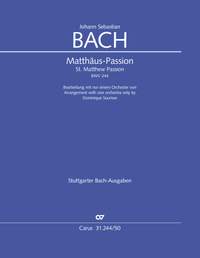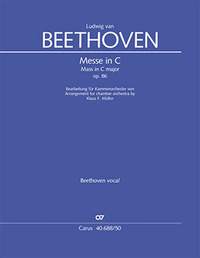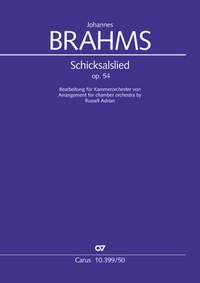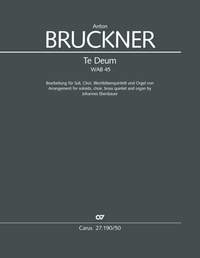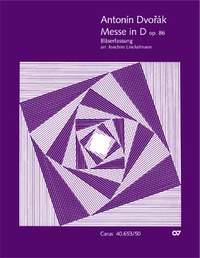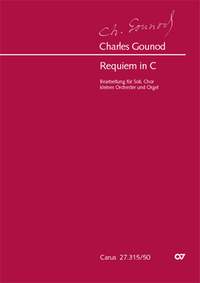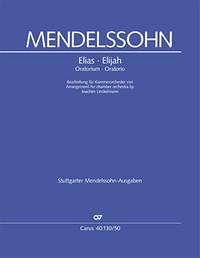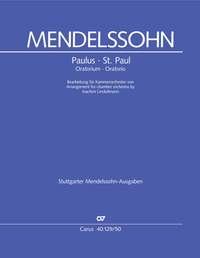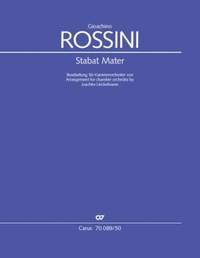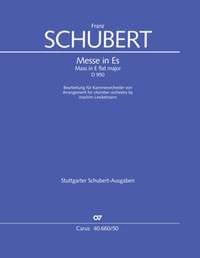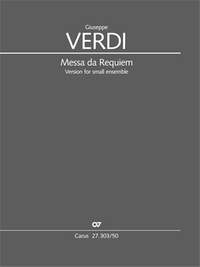Recommended Sheet Music,
Great Choral Works in Small Scorings
Have you ever considered Verdi’s Requiem with just five instead of thirty-four instrumentalists, or Mendelssohn’s Elijah with just a small chamber ensemble? With Carus' arrangements in the Great choral works in small scorings series, it is easier and considerably more economical to perform the great choral works every choir wants to sing. The publications in this series are constantly being expanded, and include arrangements of well-known choral and orchestral works by Beethoven, Haydn, Brahms, Mendelssohn, Rossini, Dvorak, Bruckner, Puccini, and Verdi There are a range of benefits from these smaller scorings. More choirs can have the opportunity to perform these large-scale works as performances can now be programmed with considerably fewer instrumentalists, and therefore can also fit into smaller performance venues. These arrangements offer a fresh look at well-known and popular works. Vocal scores and choral scores from the original versions can be used in conjunction with these publications.
In this arrangement, Sourisse combines the two orchestras, and has endeavored to retain the double-choir effect with individual solutions without ever resorting to the formulaic. With the alternative solutions offered in some movements, it is possible to perform the work with just single strings. All the vocal parts (soloists and chorus) are unaltered in the arrangement, so that the vocal scores and choral scores from the original version can be used.
Available Format: Sheet Music
Beethoven described his Missa solemnis several times as his greatest work. The scoring of seven instead of eighteen winds offers an optimal balance between transparency and orchestral sound. All the vocal parts (soloists and chorus) are identical with the original version, so that the vocal and choral score of that version can be used.
Available Format: Sheet Music
This important work of choral literature can now be performed by smaller forces thanks to this arrangement for soloists, choir and chamber orchestra. Instead of 12, just 5 wind instruments are required. The string parts can also be played by single soloists; the performance material contains suggestions about how to deal with the divisi passages. All the vocal parts (soloists and chorus) are unaltered in the arrangement, so that the vocal scores and choral scores from the original version can be used.
Available Format: Sheet Music
Since its first complete performance in 1868 in the Cathedral of Bremen, Brahms's Ein deutsches Requiem is, without question, one of the key works in the history of the oratorio. The reputation of the work is based not only on its unusually concentrated musical structure, but also on the original conception of the text: Brahms assembled important passages from both the Old and New Testaments in Luther’s translation so that thoughts on sorrow and consolation would obviously refer to one another.
Available Format: Sheet Music
With his Schicksalslied (Song of Destiny), inspired by a text by Friedrich Hölderlin, Brahms created a timeless piece of music with his personal interpretation of the idea of destiny. The work is impressive both in the concert hall and in a sacred space. With the publication of this arrangement for chamber orchestra, smaller choirs now have the opportunity of performing this work too. The scoring is identical with the chamber orchestra version of the German Requiem (see above), so that the two works can easily be combined in a concert program.
Available Format: Sheet Music
Carus published the original version of Bruckner's Te Deum for choir and large orchestra in the fall of 2015. In order to make this work available for performance by smaller-sized ensembles, Carus now presents it in an arrangement for brass quintet and organ. The brass parts are orientated essentially towards those in Bruckner's orchestral version, while the organ part follows the original string parts.
Available Format: Sheet Music
Originally composed for soli, choir and organ, Antonín Dvorák’s Mass in D major first became popular in the composer’s later version with orchestral accompaniment. Besides the original version with organ or orchestra, this arrangement for wind quintet offers colourful, chamber music-like instrumental scoring, presenting an ensemble whose size is ideal for a typical church or chamber choir, so that this beautiful work can now be performed in concert by smaller choirs.
Available Format: Sheet Music
Antonín Dvorák’s impressive Stabat Mater for soloists, chorus and orchestra is probably the best-known of the composer’s sacred works. The music enters into the different moods of the liturgical texts with great sensitivity. This arrangement for chamber orchestra allows smaller choirs the opportunity of performing this work without the choir being drowned out by a large-scale symphony orchestra. This scoring offers an optimal balance between transparency and orchestral sound.
Available Format: Sheet Music
The present setting of Psalm 150 from 1884 is one of César Franck's late works. The popularity of this work has largely been hindered by the need for large instrumental resources for so short a piece. The present arrangement of the Psalm for choir, strings and organ (ad libitum: harp and percussion) is intended as a compromise that retains much of the original sonority, but keeping the work within the scope and possibilities of churches desirous of performing works with instrumental accompaniment within the context of liturgy.
Available Format: Sheet Music
Charles Gounod composed the Requiem under the impact of the death of his 4-year-old grandson, Maurice. In 1895 it was published posthumously in various arrangements by his pupil Henri Busser. In order to make the work accessible to a wider public Carus has presented a version for a small group of instruments.
Available Format: Sheet Music
Haydn’s original orchestration is filled with vivid tone painting and this reduced version represents Haydn’s score using accurate colours for the obligato melodies and appropriate instrumental voices for the colla parte passages. Modern performances of Creation sometimes use fifty to sixty players. It is hoped that this reduction will make this beautiful work available to smaller groups, smaller performance venues, and groups with smaller budgets.
Available Format: Sheet Music
With this arrangement of Mendelssohn’s cantata Wie der Hirsch schreit (As the heart longs) smaller choirs and choirs with more limited resources of space or finance can now perform this popular work. The original symphonic wind and brass forces have been reduced from fifteen to five. All the vocal parts (soloists and chorus) are identical with the original version, so that the vocal scores and chorus scores of that version can be used.
Available Format: Sheet Music
Mendelssohn described his 1840 work Lobgesang as “a symphony for chorus and orchestra”. It is now firmly established in the standard repertoire of the major oratorio choirs. For many choirs, Lobgesang remains on their wishlist of works they want to sing. But what can be done if the choir is too small, the budget is limited, and the performance space is tight?
Available Format: Sheet Music
With this arrangement for chamber orchestra, smaller choirs can now also perform this work. By reducing the symphonic wind and brass in particular (instead of 18 just seven single wind and brass instruments are now required), the volume of sound is more restrained, but the symphonic character and a wide dynamic range are retained. All the vocal parts (soloists and chorus) are identical with the original version, so that the vocal scores and choral scores from that version can be used.
Available Format: Sheet Music
Mendelssohn’s St. Paul with just seven instead of the usual 18 wind instruments? Thanks to this arrangement for chamber orchestra, a performance with smaller forces is now possible, and presents an attractive alternative for performing Mendelssohn’s first oratorio.
Available Format: Sheet Music
Puccini composed his Messa a 4 voci con orchestra in 1878–1880. The musical quality, the energy, and the freshness of this youthful work led the composer to quote from his Mass in later operas, ensuring an ever-growing popularity for the work after its rediscovery in 1952. With this arrangement for chamber orchestra, more choirs now have the opportunity of performing this work without the choir being dominated by a full-scale symphony orchestra. The symphonic character of the work is nevertheless preserved. This scoring offers an optimal balance between transparency and orchestral sound.
Vocal and choral scores, and Carus Choir Coach editions also available .
Available Format: Sheet Music
Following his early departure from the opera stage in 1829, besides chamber music Gioachino Rossini composed larger scored works of church music. The Stabat Mater is among these. It was composed in two different phases between 1831 and 1841 and received its premiere in Paris in 1842. In ten movements Rossini unites different forms such as aria, duet, quartet and chorus, an operatic aria-like style of writing as well as a strict a cappella style resulting in one of the highpoints of this genre.
Available Format: Sheet Music
Saint-Saëns’ colourful Messe de Requiem op. 54, originally opulently scored, is published here in an ingenious reduced version, so that smaller choirs, and choirs with more limited resources of space or finance can also perform this attractive work with smaller instrumental forces.
Available Format: Sheet Music
Here the experienced arranger and orchestral musician Joachim Linckelmann has created a version for soloists, choir and chamber orchestra which requires only 7 winds rather than the original 13. The string parts, while identical to the original, can now also be scaled back. The vocal parts (soloists and chorus) are completely untouched by the arrangement.
Available Format: Sheet Music
The choir director and music pedagogue Michael Betzner-Brandt from Berlin is particularly renowned in the choir scene for his creativity. In order to perform Verdi's Requiem with his chamber choir, he arranged the work as a "chamber oratorio". The piano reduction, which forms the foundation, is expanded by parts for horn, double bass, marimba and percussion. The expressive orchestral timbres of the original are not lost, but transformed into more delicate shades.
Available Format: Sheet Music



